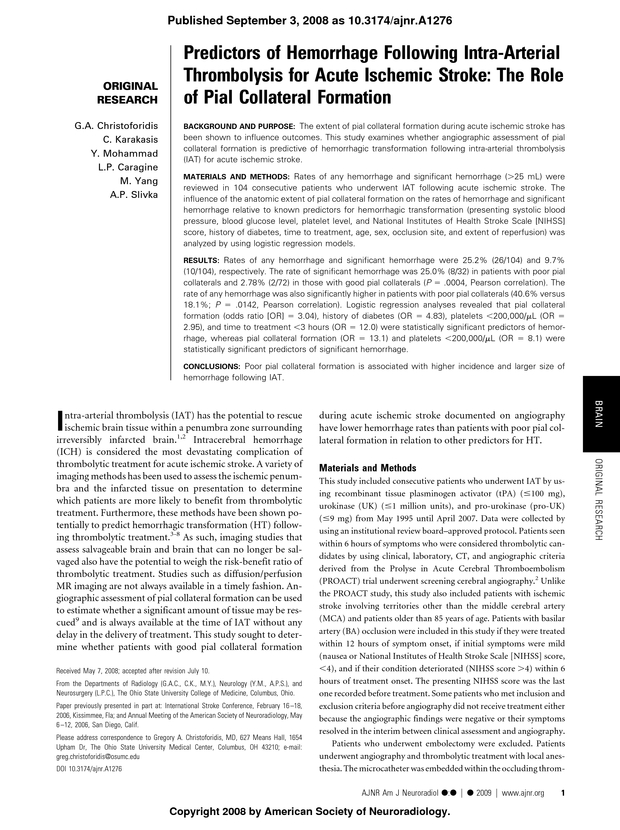OtherBRAIN
Predictors of Hemorrhage Following Intra-Arterial Thrombolysis for Acute Ischemic Stroke: The Role of Pial Collateral Formation
G.A. Christoforidis, C. Karakasis, Y. Mohammad, L.P. Caragine, M. Yang and A.P. Slivka
American Journal of Neuroradiology September 2008, DOI: https://doi.org/10.3174/ajnr.A1276
G.A. Christoforidis
C. Karakasis
Y. Mohammad
L.P. Caragine
M. Yang


This is a PDF-only article. The first page of the PDF of this article appears above.
Advertisement
G.A. Christoforidis, C. Karakasis, Y. Mohammad, L.P. Caragine, M. Yang, A.P. Slivka
Predictors of Hemorrhage Following Intra-Arterial Thrombolysis for Acute Ischemic Stroke: The Role of Pial Collateral Formation
American Journal of Neuroradiology Sep 2008, DOI: 10.3174/ajnr.A1276
0 Responses
Jump to section
Related Articles
- No related articles found.
Cited By...
- Systematic review protocol to assess artificial intelligence diagnostic accuracy performance in detecting acute ischaemic stroke and large-vessel occlusions on CT and MR medical imaging
- Multi-ancestry genetic study in 5,876 patients identifies an association between excitotoxic genes and early outcomes after acute ischemic stroke
- The impact of general anesthesia, baseline ASPECTS, time to treatment, and IV tPA on intracranial hemorrhage after neurothrombectomy: pooled analysis of the SWIFT PRIME, SWIFT, and STAR trials
- Guidelines for evaluation and management of cerebral collateral circulation in ischaemic stroke 2017
- Collateral status affects the onset-to-reperfusion time window for good outcome
- Role of Genetic Variation in Collateral Circulation in the Evolution of Acute Stroke: A Multimodal Magnetic Resonance Imaging Study
- Fluid-Attenuated Inversion Recovery Vascular Hyperintensity Topography, Novel Imaging Marker for Revascularization in Middle Cerebral Artery Occlusion
- Comparison of four different collateral scores in acute ischemic stroke by CT angiography
- Comparing Vessel Imaging: Noncontrast Computed Tomography/Computed Tomographic Angiography Should Be the New Minimum Standard in Acute Disabling Stroke
- Determinants of Intracranial Hemorrhage Occurrence and Outcome after Neurothrombectomy Therapy: Insights from the Solitaire FR With Intention For Thrombectomy Randomized Trial
- Poor Collateral Circulation Assessed by Multiphase Computed Tomographic Angiography Predicts Malignant Middle Cerebral Artery Evolution After Reperfusion Therapies
- Impact of Time-to-Reperfusion on Outcome in Patients with Poor Collaterals
- Congenic Fine-Mapping Identifies a Major Causal Locus for Variation in the Native Collateral Circulation and Ischemic Injury in Brain and Lower Extremity
- Diabetes Mellitus, Admission Glucose, and Outcomes After Stroke Thrombolysis: A Registry and Systematic Review
- Factors associated with rapid neurological improvement 24 h following intra-arterial thrombolytic treatment for acute ischemic stroke
- Reperfusion Rates Following Intra-Arterial Thrombolysis for Acute Ischemic Stroke: The Influence of the Method for Alteplase Delivery
- Endovascular Therapy of 623 Patients With Anterior Circulation Stroke
- Systematic Review of Methods for Assessing Leptomeningeal Collateral Flow
- Extending the Time Window for Endovascular Procedures According to Collateral Pial Circulation
- Patient Outcomes With Endovascular Embolectomy Therapy for Acute Ischemic Stroke: A Study of the National Inpatient Sample: 2006 to 2008
- Predictors of Subarachnoid Hemorrhage in Acute Ischemic Stroke With Endovascular Therapy
- Genetic Architecture Underlying Variation in Extent and Remodeling of the Collateral Circulation
- Higher Rates of Mortality but Not Morbidity Follow Intracranial Mechanical Thrombectomy in the Elderly
- Occurrence and Predictors of Futile Recanalization following Endovascular Treatment among Patients with Acute Ischemic Stroke: A Multicenter Study
- Impact of Baseline Tissue Status (Diffusion-Weighted Imaging Lesion) Versus Perfusion Status (Severity of Hypoperfusion) on Hemorrhagic Transformation
This article has been cited by the following articles in journals that are participating in Crossref Cited-by Linking.
- Glen C Jickling, DaZhi Liu, Boryana Stamova, Bradley P Ander, Xinhua Zhan, Aigang Lu, Frank R SharpJournal of Cerebral Blood Flow & Metabolism 2014 34 2
- Jialing Liu, Yongting Wang, Yosuke Akamatsu, Chih Cheng Lee, R. Anne Stetler, Michael T. Lawton, Guo-Yuan YangProgress in Neurobiology 2014 115
- Hua Zhang, Pranay Prabhakar, Robert Sealock, James E FaberJournal of Cerebral Blood Flow & Metabolism 2010 30 5
- Jean-Philippe Desilles, Elena Meseguer, Julien Labreuche, Bertrand Lapergue, Gaia Sirimarco, Jaime Gonzalez-Valcarcel, Philippa Lavallée, Lucie Cabrejo, Celine Guidoux, Isabelle Klein, Pierre Amarenco, Mikael MazighiStroke 2013 44 7
- F. McVerry, D.S. Liebeskind, K.W. MuirAmerican Journal of Neuroradiology 2012 33 3
- H.M. Hussein, A.L. Georgiadis, G. Vazquez, J.T. Miley, M.Z. Memon, Y.M. Mohammad, G.A. Christoforidis, N. Tariq, A.I. QureshiAmerican Journal of Neuroradiology 2010 31 3
- Aekaterini Galimanis, Simon Jung, Marie-Luise Mono, Urs Fischer, Oliver Findling, Anja Weck, Niklaus Meier, Gian Marco De Marchis, Caspar Brekenfeld, Marwan El-Koussy, Heinrich P. Mattle, Marcel Arnold, Gerhard Schroth, Jan GrallaStroke 2012 43 4
- Guidelines for evaluation and management of cerebral collateral circulation in ischaemic stroke 2017Liping Liu, Jing Ding, Xinyi Leng, Yuehua Pu, Li-An Huang, Anding Xu, Ka Sing Lawrence Wong, Xin Wang, Yongjun WangStroke and Vascular Neurology 2018 3 3
- Marc Ribo, Alan Flores, Marta Rubiera, Jorge Pagola, Joao Sargento-Freitas, David Rodriguez-Luna, Pilar Coscojuela, Olga Maisterra, Socorro Piñeiro, Francisco J. Romero, Jose Alvarez-Sabin, Carlos A. MolinaStroke 2011 42 12
- Shiliang Wang, Hua Zhang, Xuming Dai, Robert Sealock, James E. FaberCirculation Research 2010 107 4
More in this TOC Section
Similar Articles
Advertisement










